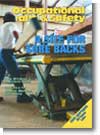
December 2005
Cover Story
By Jerry Laws
Editor's note: New guidelines to increase the safety of manual handling tasks are being finalized by a partnership that includes NIOSH, CAL/OSHA, the Material Handling Industry of America's EASE Council (Ergonomics Assist and Systems Equipment), and five other entities. The EASE Council's chairman is James J. Galante, director of Product and Market Development for Southworth Products Corp., the largest manufacturer in the world of lifting and positioning equipment for material handling applications.
Features
By Hank Constantine
SUDDEN cardiac arrest (SCA) is an abrupt disruption of the heart's function that causes lack of blood flow to vital organs. This lack of blood flow results in loss of blood pressure, pulse, and consciousness. Most commonly, SCA is caused by a type of arrhythmia (abnormal heart rhythm) called ventricular fibrillation, or VF.
By David Szczepanik
With the media's focus on highway accidents involving bulk containers, resulting fatalities, and environmental pollution, we tend to forget the vast majority of hazardous materials are shipped in non-bulk containers such as paint cans, bottles, metal drums, pressurized cylinders, and cardboard boxes. Inside are flammable, corrosive, and poisonous liquids; gases; infectious substances; radioactive materials; and explosives, separated only by the containment method, the package.
By Jim Boerger, PE
THE evolution of automated doors during the past 40 years has provided real benefits to industrial customers. The ongoing changeover from slow, rigid doors to high-speed doors has brought about tremendous strides in the areas of increased productivity and energy savings.
By W. Jon Wallace, CSP, MBA
THOUSANDS of people are blinded each year from work-related eye injuries that could have been prevented with the proper selection and use of eye and face protection.
By Joe Unangst
YOU are sleeping soundly in your own bed, for a change, after spending the better part of two weeks at the site of a chemical warehouse fire, where you assessed exposure--or the lack thereof, as it turned out--of neighboring buildings and the employees who inhabit them.
By Keith Miller
TRADITIONAL methods for illuminating signage are giving way to new/old technology. I say new/old because Light Emitting Diodes, or LEDs, have been around since the 1960s. The technology has caught up and enabled LEDs to become commonplace within the last five to seven years because of new processes and the fact that materials have become less expensive to produce.
By Tricia S. Hodkiewicz
EMERGENCY responders have helped protect Americans from hazardous substance releases since our nation's beginnings. From the bucket brigades of colonial times to today's in-plant and community hazardous materials response teams, response workers have taken action during emergency releases to save lives, preserve property, and protect the public good.
Departments
By Jerry Laws
A 90-day postponement delayed it just as this column was being written, but the tug of war over OSHA's proposed expansion of 29 CFR 1910.269 and related rules is still looming. Shortly before the comment period's original closing date of Oct. 13, about 40 people had filed notices of intent to appear at the agency's hearing that was moved to March 6, 2006, in Washington, D.C.
By Marc Barrera
THE place is a desolate, stinking, swampland speckled with the remains of a past civilization. Upended cars and rooftops serve as makeshift perches for birds who keep constant focus on an approaching alligator.
By Randy DeVaul
EMPLOYERS and employees have a vested interest in performing tasks safely at work. Employers want to ensure their most valuable assets (their people) are safe and protected from hazards while making sure they cover all of the compliance requirements for establishing and maintaining a safe work environment that is free of recognized hazards.